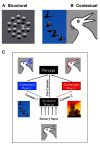Learning what to expect (in visual perception)
- PMID: 24187536
- PMCID: PMC3807544
- DOI: 10.3389/fnhum.2013.00668
Learning what to expect (in visual perception)
Abstract
Expectations are known to greatly affect our experience of the world. A growing theory in computational neuroscience is that perception can be successfully described using Bayesian inference models and that the brain is "Bayes-optimal" under some constraints. In this context, expectations are particularly interesting, because they can be viewed as prior beliefs in the statistical inference process. A number of questions remain unsolved, however, for example: How fast do priors change over time? Are there limits in the complexity of the priors that can be learned? How do an individual's priors compare to the true scene statistics? Can we unlearn priors that are thought to correspond to natural scene statistics? Where and what are the neural substrate of priors? Focusing on the perception of visual motion, we here review recent studies from our laboratories and others addressing these issues. We discuss how these data on motion perception fit within the broader literature on perceptual Bayesian priors, perceptual expectations, and statistical and perceptual learning and review the possible neural basis of priors.
Keywords: Bayesian priors; expectations; perceptual learning; probabilistic inference; statistical learning.
Figures



Similar articles
-
Acquisition of visual priors and induced hallucinations in chronic schizophrenia.Brain. 2019 Aug 1;142(8):2523-2537. doi: 10.1093/brain/awz171. Brain. 2019. PMID: 31257444 Free PMC article.
-
Learning What to See in a Changing World.Front Hum Neurosci. 2016 May 31;10:263. doi: 10.3389/fnhum.2016.00263. eCollection 2016. Front Hum Neurosci. 2016. PMID: 27303285 Free PMC article.
-
Complexity and specificity of experimentally-induced expectations in motion perception.J Vis. 2013 Mar 13;13(4):8. doi: 10.1167/13.4.8. J Vis. 2013. PMID: 23487160
-
Priors in perception: Top-down modulation, Bayesian perceptual learning rate, and prediction error minimization.Conscious Cogn. 2017 Jan;47:75-85. doi: 10.1016/j.concog.2016.09.004. Epub 2016 Sep 20. Conscious Cogn. 2017. PMID: 27663763 Review.
-
Computational Neuropsychology and Bayesian Inference.Front Hum Neurosci. 2018 Feb 23;12:61. doi: 10.3389/fnhum.2018.00061. eCollection 2018. Front Hum Neurosci. 2018. PMID: 29527157 Free PMC article. Review.
Cited by
-
Expectations developed over multiple timescales facilitate visual search performance.J Vis. 2015;15(9):10. doi: 10.1167/15.9.10. J Vis. 2015. PMID: 26200891 Free PMC article.
-
The Thalamus as a Blackboard for Perception and Planning.Front Behav Neurosci. 2021 Mar 1;15:633872. doi: 10.3389/fnbeh.2021.633872. eCollection 2021. Front Behav Neurosci. 2021. PMID: 33732119 Free PMC article.
-
An investigation of far and near transfer in a gamified visual learning paradigm.PLoS One. 2019 Dec 26;14(12):e0227000. doi: 10.1371/journal.pone.0227000. eCollection 2019. PLoS One. 2019. PMID: 31877187 Free PMC article.
-
Is Social Training Delivered with a Head-Mounted Display Suitable for Patients with Hereditary Ataxia?Brain Sci. 2023 Jun 30;13(7):1017. doi: 10.3390/brainsci13071017. Brain Sci. 2023. PMID: 37508949 Free PMC article.
-
Acquisition of visual priors and induced hallucinations in chronic schizophrenia.Brain. 2019 Aug 1;142(8):2523-2537. doi: 10.1093/brain/awz171. Brain. 2019. PMID: 31257444 Free PMC article.
References
Publication types
LinkOut - more resources
Full Text Sources
Other Literature Sources

